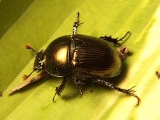
Earth-boring dung beetle
Encyclopedia
Geotrupidae is a family
of beetles in the order
Coleoptera. They are commonly called dor beetles or earth-boring dung beetles. Most excavate burrow
s in which to lay their eggs. They are typically detrivores, provisioning their nests with leaf litter (often moldy), but are occasionally coprophagous, similar to dung beetle
s. The eggs
are laid in or upon the provision mass and buried, and the developing larvae feed upon the provisions. The burrows of some species can exceed 2 metres in depth.
A few species communicate by stridulation
(rubbing body parts together to make sounds).
segments, but examination of a different set of characteristics prompted Scholtz & Browne (1995) to elevate Bolboceratidae to a family.
The family has more than 600 species in about 30 genera in three subfamilies.
Family (biology)
In biological classification, family is* a taxonomic rank. Other well-known ranks are life, domain, kingdom, phylum, class, order, genus, and species, with family fitting between order and genus. As for the other well-known ranks, there is the option of an immediately lower rank, indicated by the...
of beetles in the order
Order (biology)
In scientific classification used in biology, the order is# a taxonomic rank used in the classification of organisms. Other well-known ranks are life, domain, kingdom, phylum, class, family, genus, and species, with order fitting in between class and family...
Coleoptera. They are commonly called dor beetles or earth-boring dung beetles. Most excavate burrow
Burrow
A burrow is a hole or tunnel dug into the ground by an animal to create a space suitable for habitation, temporary refuge, or as a byproduct of locomotion. Burrows provide a form of shelter against predation and exposure to the elements, so the burrowing way of life is quite popular among the...
s in which to lay their eggs. They are typically detrivores, provisioning their nests with leaf litter (often moldy), but are occasionally coprophagous, similar to dung beetle
Dung beetle
Dung beetles are beetles that feed partly or exclusively on feces. All of these species belong to the superfamily Scarabaeoidea; most of them to the subfamilies Scarabaeinae and Aphodiinae of the family Scarabaeidae. This beetle can also be referred to as the scarab beetle. As most species of...
s. The eggs
Egg (biology)
An egg is an organic vessel in which an embryo first begins to develop. In most birds, reptiles, insects, molluscs, fish, and monotremes, an egg is the zygote, resulting from fertilization of the ovum, which is expelled from the body and permitted to develop outside the body until the developing...
are laid in or upon the provision mass and buried, and the developing larvae feed upon the provisions. The burrows of some species can exceed 2 metres in depth.
A few species communicate by stridulation
Stridulation
Stridulation is the act of producing sound by rubbing together certain body parts. This behavior is mostly associated with insects, but other animals are known to do this as well, such as a number of species of fishes, snakes and spiders...
(rubbing body parts together to make sounds).
Classification
They were originally classified as the subfamily Geotrupinae in the family Scarabaeidae before being elevated to a family. Traditionally the family Bolboceratidae was included (as the subfamily Bolboceratinae) on the basis of the number of antennaAntenna (biology)
Antennae in biology have historically been paired appendages used for sensing in arthropods. More recently, the term has also been applied to cilium structures present in most cell types of eukaryotes....
segments, but examination of a different set of characteristics prompted Scholtz & Browne (1995) to elevate Bolboceratidae to a family.
The family has more than 600 species in about 30 genera in three subfamilies.
- Geotrupinae
- Allotrypes François, 1904
- Anoplotrupes Jekel, 1866
- Baraudia López-Colón, 1996
- Ceratophyus Fischer von WaldheimJohann Fischer von WaldheimJohann Gotthelf Fischer von Waldheim was a German anatomist, entomologist and paleontologist....
, 1823 - Ceratotrupes Jekel, 1865
- Chelotrupes Jekel, 1866
- Cnemotrupes Jekel, 1866
- Cretogeotrupes Nikolajev, 1992
- Enoplotrupes Lucas, 1869
- Geohowdenius Zunino, 1984
- GeotrupesGeotrupesGeotrupes is a genus of dor beetles and the type genus of its tribe....
LatreillePierre André LatreillePierre André Latreille was a French zoologist, specialising in arthropods. Having trained as a Roman Catholic priest before the French Revolution, Latreille was imprisoned, and only regained his freedom after recognising a rare species he found in the prison, Necrobia ruficollis...
, 1796 - Halffterius Zunino, 1984
- Haplogeotrupes Nikolaev, 1979
- Jekelius López-Colón, 1989
- Megatrupes Zunino, 1984
- Mycotrupes LeConteJohn Lawrence LeConteJohn Lawrence LeConte was the most important American entomologist of the 19th century, responsible for naming and describing approximately half of the insect taxa known in the United States during his lifetime, including some 5,000 species of beetles...
, 1866 - Odontotrypes Fairmaire, 1887
- Onthotrupes Howden, 1964
- Phelotrupes Jekel, 1866
- Peltotrupes Blanchard, 1888
- Pseudotrypocopris Miksic, 1954
- Sericotrupes Zunino, 1984
- Silphotrupes Jekel, 1866
- Thorectes Mulsant, 1842
- Trypocopris Motschulsky, 1860
- Typhaeus Leach, 1815
- Zuninoeus López-Colón, 1989
- Taurocerastinae
- Frickius Germain, 1897
- Taurocerastes PhilippiRodolfo Amando PhilippiRodolfo Amando Philippi was a German-Chilean paleontologist and zoologist....
, 1866
- Lethrinae
- Lethrus Scopoli, 1777
External links
- D. Jonathan Browne and Clarke H. Scholtz, Bolboceratidae, from the Tree of Life
- Key to the British species of family Geotrupidae
- Video of Geotrupes from Hungary

